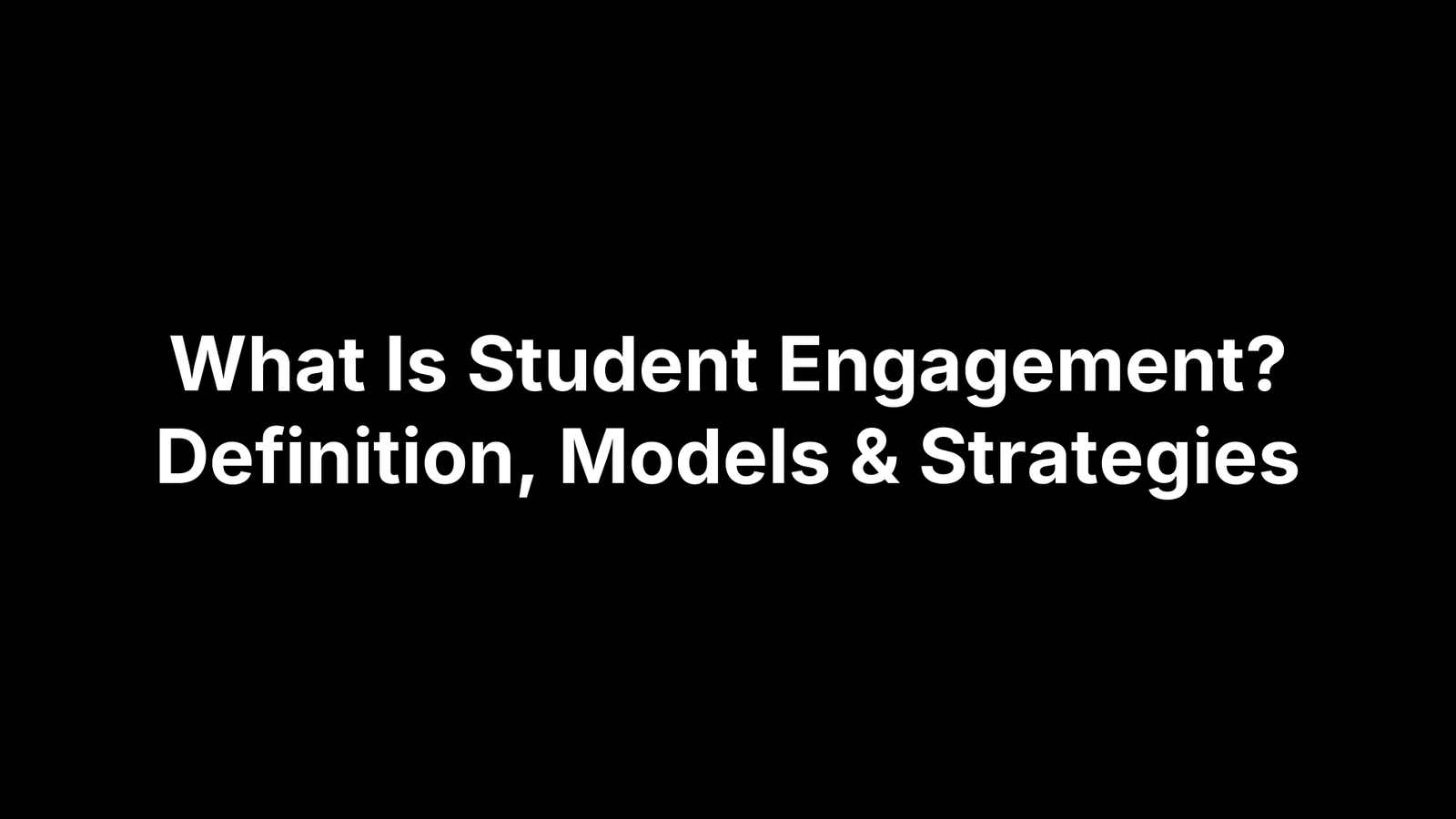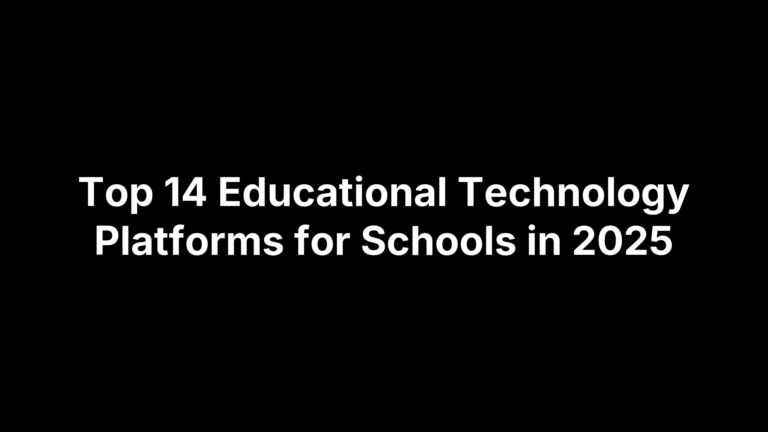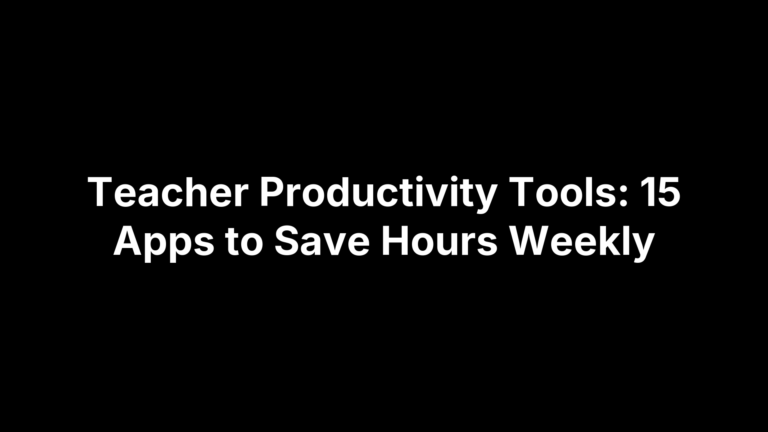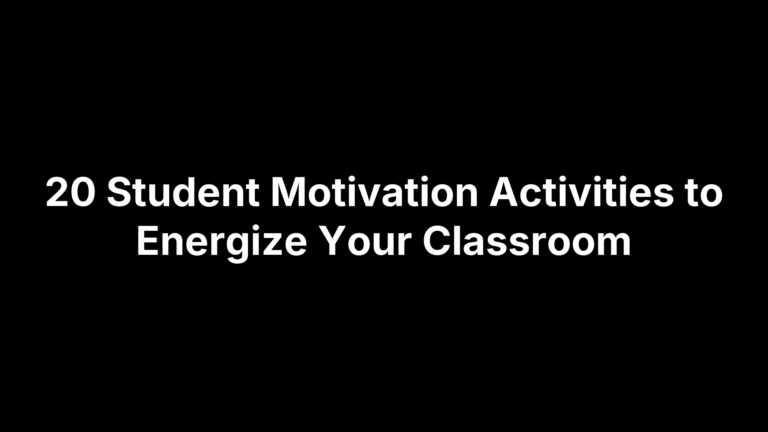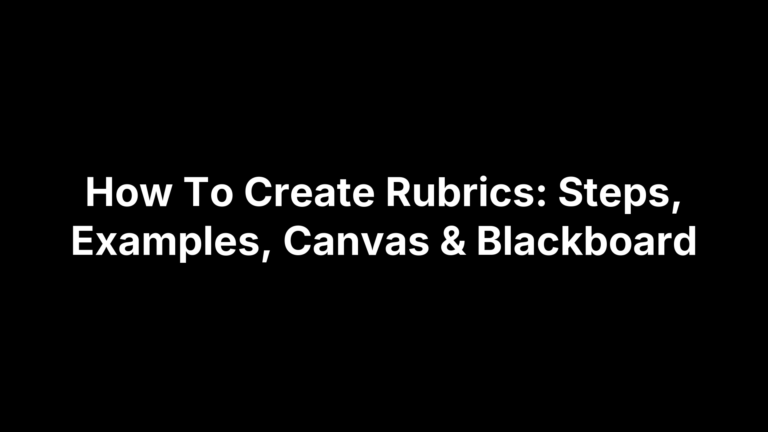Understanding Student Engagement: Models, Measurement, and Examples
Student engagement is the depth of attention, curiosity, optimism, and perseverance students bring to learning tasks, translating into visible participation and invisible cognitive and emotional investment. Unlike simple rule-following, real engagement pulses through raised hands that actually hold questions, minds that wrestle with ideas, and hearts that care whether the work matters.
Multidimensional by nature, engagement shows up behaviorally, cognitively, socially, and even physically, so a student glued to a simulation can be as engaged as a group debating on their feet. Understanding those layers matters because engagement predicts everything from quiz scores to graduation rates—and it can be measured, nurtured, and rescued when it slips. In the sections ahead, you’ll find research-based definitions, leading models, practical measurement tools, proven classroom tactics, ways to re-engage disconnected learners, guidance for online settings, and a 30-day action plan you can start tomorrow— all distilled for busy educators and immediately usable.
A Working Definition of Student Engagement
Teachers need a pocket definition they can quote in meetings or paste into a lesson plan.
Core definition and key characteristics
Student engagement equals focused attention, sparked curiosity, hopeful interest, and committed effort. These qualities appear on a continuum:
| Level | Snapshot |
|---|---|
| Disengaged | Off-task, withdrawn |
| Compliant | Follows directions, minimal thought |
| Engaged | Questions and connects ideas |
| Empowered | Extends learning, mentors peers |
Student engagement vs. simple compliance or participation
Hands can be raised while minds wander—participation. Compliance is quiet worksheet completion. Engagement, by contrast, shows in probing questions, risk-taking, and students explaining concepts without prompts.
In-class, school-wide, and community engagement
Engagement scales: a single task, a whole-class culture, or the wider school ecosystem of clubs, service projects, and family partnerships that nurture lasting belonging.
Why Student Engagement Matters: Outcomes, Equity, and Well-Being
When student engagement is high, everything else moves in the right direction—grades, behavior, and even future earnings. It is the keystone variable teachers can influence today that keeps paying dividends tomorrow.
Academic achievement and retention
Decades of meta-analyses tie engaged learning time to higher unit test scores and year-end GPA gains. Two quick pulse points:
- Assignment-completion rate (%)
- Average formative-assessment score
When either metric rises, dropout risk falls; engaged eighth-graders are up to 44 % more likely to finish high school.
Social-emotional benefits and classroom climate
Engaged students feel they belong, which dampens anxiety and cuts discipline referrals. Picture a class where students debate respectfully—off-task chatter plummets because the work already meets their need for connection, autonomy, and competence.
Long-term success and career readiness
Employers clamor for the 4Cs. Students who regularly practice collaboration, communication, creativity, and critical thinking in school report stronger workplace confidence and earn higher early-career wages. Engagement today, opportunity tomorrow.
Dimensions and Models of Student Engagement
Researchers slice engagement in several compatible ways; knowing each lens helps you spot gaps and design tighter lessons. Below is a whirlwind tour—keep what clarifies your practice and feel free to blend the rest.
The Four Types Model: Behavioral, Cognitive, Social-Emotional, Physical
- Behavioral – on-task actions (note-taking, tool use). Try “traffic-light” self-checks.
- Cognitive – mental effort (questioning, summarizing). Use retrieval quizzes.
- Social-Emotional – belonging and value. Open each unit with identity-affirming surveys.
- Physical – movement tied to thinking. Run stand-up debates or VR labs.
The 4Cs Framework for 21st-Century Skills
Engagement soars when tasks demand:
- Collaboration
- Communication
- Creativity
- Critical thinking
Quick design check: does the lesson include at least two Cs? If not, tweak.
The 5Cs From the Student Perspective
Students say they engage when they have: Control, Complexity, Common Bonds, Choice, Caring Teachers. Micro-apply by letting groups pick product formats or by joining their lunchtime club for rapport.
Kahu’s Conceptual Framework and Engagement Zone Model
Kahu separates structural levers (time, resources, policies) from psychological drivers (motivation, self-efficacy). Sketch a Venn diagram on the board to show where classroom design and student mindset overlap—the “engagement zone.”
Making sense of multiple models
Common threads: autonomy, relevance, relationships, and purposeful challenge.
Takeaways:
- Mix observable behavior with inner thinking cues
- Build tasks that matter to students’ worlds
- Support effort through clear structures and warm teacher presence
Measuring and Assessing Engagement
Before we can move the engagement needle, we have to see where it sits. Combine quick observations, student voice, and digital breadcrumbs to create a 360-degree picture you can revisit week after week.
Observable indicators and student behaviors
Look for concrete actions you can tally during a lesson:
- Quality of notes (complete, partial, none)
- Time-on-task (stopwatch 2-minute samples)
- Questions asked vs. answered
- Peer-to-peer explanations
Logging these numbers on a clipboard or tablet turns gut feelings into trend lines.
Surveys, checklists, and self-assessment tools
Short Likert items—“I felt challenged today” (1-5)—offer instant class mood scans. Pair them with exit-ticket prompts like “One idea I’m still puzzling over…” to capture cognitive and emotional engagement in students’ own words.
Real-time digital analytics
Polling apps, interactive slides, and LMS dashboards display participation heat maps, response latency, and completion rates. When the orange bars cool to blue, you know exactly when attention sagged and can reteach or retool.
Designing an engagement rubric
Create a four-level grid aligned with behavioral, cognitive, social-emotional, and physical domains. Example row for “Cognitive”:
- Passive recall
- Minimal connections
- Frequent questioning
- Synthesizes and extends learning
Share the rubric with students so assessment becomes a roadmap, not a surprise.
Classroom Strategies to Boost Engagement
Good models and metrics are only useful if they translate into action. The tactics below turn abstract theories of what is student engagement into everyday routines that keep students mentally, emotionally, and physically invested.
Universal Design for Learning and differentiated instruction
UDL asks teachers to provide multiple means of representation, action/expression, and engagement. Picture an 8th-grade history lesson on the Harlem Renaissance:
- Representation – mini-lecture with images, audio clips of jazz, and a primary-source gallery walk
- Action/Expression – students choose between a podcast script, infographic, or short essay to demonstrate learning
- Engagement – small goal-setting check-ins and a “two things I wonder” exit ticket
Coupled with the site’s AI Differentiated Instruction Helper, the same lesson easily scales for reading levels or language proficiency.
Active learning techniques: think-pair-share, project-based learning, and gamification
- Think-Pair-Share:
- Pose a juicy question, give 60 silent seconds, then pairs compare notes before whole-class share-out.
- Low-prep variation: digital “pair” via chat for hybrid classes.
- Project-Based Learning (PBL): anchor units around an authentic driving question—“How can we reduce cafeteria waste by 30 %?”—and end with a public product.
- Gamification: layer progress bars or badge levels onto existing units. High-prep: full narrative quest. Low-prep: weekly leaderboard for formative-quiz mastery.
Incorporating learner voice and choice
Choice signals trust and autonomy, two proven engagement accelerators. Try a five-item choice board:
| Pick One Product | Audience | Required Tool |
|---|---|---|
| TikTok-style explainer | Peers | Phone/video app |
| Op-ed letter | School board | Word processor |
| Comic strip | 6th graders | Canva |
| Podcast episode | Community | Mic + editor |
| Live demo | Parent night | Any visuals |
Let students co-create rubrics and submit one self-generated quiz question per unit for bonus credit.
Culturally responsive and inclusive practices
Learning sticks when it feels relevant. Connect content to students’ lives—use local census data in math class, invite elders to share oral histories, or let multilingual students caption class videos. Establish discussion norms that value every dialect and perspective.
Leveraging technology and AI tools
Interactive simulations, adaptive quizzes, and AI-powered question generators give instant feedback while freeing teacher time for personalized coaching. LMS analytics spotlight who is thriving and who needs nudges; real-time polls keep even quiet students visible. Used thoughtfully, tech amplifies human connection rather than replacing it.
Addressing Barriers and Re-Engaging Disconnected Students
Even the best-designed lessons hit bumps—illness, peer drama, a tough unit—so having a re-engagement playbook is non-negotiable. The key is spotting trouble early, matching supports to need, and rebuilding trust one interaction at a time.
Common causes of disengagement
| Cause | First-line response |
|---|---|
| Skill gaps | Provide just-in-time mini-lessons and scaffolded practice |
| Social-emotional stress | Offer quiet check-ins or counselor referral |
| Cultural irrelevance | Connect content to students’ lived experiences |
| Classroom climate | Reset norms and include student voice in rule revisions |
Early warning signs and data points to monitor
- Attendance dip of 2+ days in a month
- Two consecutive missing assignments
- Fewer chat or verbal contributions than baseline
- Body language: slumped posture, closed laptop, avoidance of eye contact
A simple color-coded spreadsheet flags students when two indicators trigger.
Tiered interventions and support strategies
- Universal: brain breaks, clear success criteria
- Targeted: small-group reteach, goal-setting conference
- Individual: personalized learning contract, peer mentor pairing
Escalate only as needed; keep families in the loop early.
Building strong teacher-student relationships
- Greet by name at the door
- Use interest inventories to weave hobbies into examples
- Schedule two-minute “non-academic” chats weekly
- Practice restorative conversations after conflicts
Relationships aren’t fluff—they’re the runway for re-engagement.
Engagement in Online, Hybrid, and Flipped Classrooms
Screens don’t automatically shrink attention spans—poor design does. Translating what is student engagement to virtual spaces just means swapping hand-raising for clicks, hallway chatter for discussion threads, and teacher presence for strategic check-ins.
Designing interactive virtual lessons
Chunk videos under 8 minutes, embed quiz questions every 2–3 minutes, and mix in breakout-room brainstorms or collaborative whiteboards to reset attention.
Building community at a distance
Kick off with emoji icebreakers, establish “reply to two peers” norms, and schedule informal coffee-chat sessions so relationships outlive the mute button.
Maintaining momentum and accountability
Post a predictable weekly roadmap, use micro-deadlines, and display progress bars inside the LMS so students always know “what’s next” and “how far.”
Tools for feedback and presence
Video comments, emoji reactions, instant polls, and auto-scored practice quizzes deliver low-latency feedback, while short selfie updates keep the human on the other side of the screen.
From Theory to Practice: A 30-Day Engagement Action Plan
Big shifts start with bite-size moves. Use the calendar below to turn the research on what is student engagement into daily classroom habits without overwhelming yourself or your students.
Week 1: Audit current practices and set measurable goals
- Collect baseline data (attendance, time-on-task, exit tickets).
- Draft one SMART goal, e.g., “Increase average formative-quiz participation from 65 % to 80 %.”
Week 2: Introduce quick-win engagement tactics
- Add a daily think-pair-share and a two-question pulse survey.
- Celebrate visible improvements with public shout-outs or digital badges.
Week 3: Collect feedback and iterate
- Run a five-item student survey; compare results to Week 1.
- Tweak tasks for relevance, autonomy, or challenge based on responses.
Week 4: Scale and sustain through routines
- Automate data capture with LMS analytics.
- Rotate student leadership roles and schedule monthly reflection checkpoints to keep momentum alive.
Keep Students Curious and Connected
Student engagement is the blend of attention, curiosity, optimism, and grit learners pour into any task. When that mix is present, grades rise, behavior steadies, and students leave class equipped with the 4 Cs employers crave.
You now have research-backed models, measurement tools, and a 30-day rollout plan packed with UDL, active-learning, and culturally responsive moves that keep the spark alive. Pick one tactic tomorrow, track its effect, and iterate—small wins add up fast.
For more classroom-ready resources and free AI tools that cut prep time so you can focus on engagement, swing by The Cautiously Optimistic Teacher. Together, we’ll keep kids curious, connected, and confident in their capacity to tackle whatever challenge comes next.
